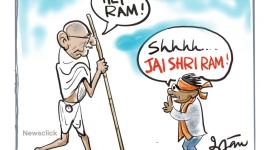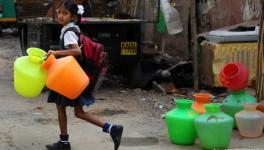Environment: Bihar Most Polluted During the Winter, Says Report
Patna: Bihar was one of the most polluted regions in the country during the winter of 2021-22 (October 15 to February 28), as revealed in the latest All-India winter air quality analysis by the Centre for Science and Environment (CSE), a New Delhi based non-profit organisation.
As per the air quality analysis, the regional profile of winter pollution shows the eastern region is as polluted as Delhi-NCR: The winter average of PM2.5 in eastern plains includes the newly monitored 19 cities and towns of Bihar, which was the same as that of Delhi-NCR. Six Bihar towns feature in the top 10 most polluted cities this winter, with Siwan and Munger at the top. In the northern plains, Ghaziabad, Delhi, Faridabad, and Manesar are third, fifth, seventh, and tenth, respectively Even though the seasonal average in smaller cities of Bihar rivals the megacities of NCR, their peak pollution during smog episodes are comparatively milder.
Smaller cities of Bihar recorded higher pollution during winter than big cities of Delhi-NCR: Siwan in Bihar was the most polluted city in India this winter, with a seasonal average of 187 ug/m3. Thirteen cities of Bihar feature in the top 25 cities with the highest levels in winter. Delhi-NCR had 11 cities on the list. Hisar in northern Haryana was the only city in the top 25 outside the sub-regions of Bihar and NCR.
Two cities in the region show an increasing trend, both winter average and peak increased compared to their previous winter. Hajipur in Bihar saw a jump of 51% in the winter average and a 54% increase in peak. Talcher in Odisha registered a 1% increase in winter average and a 16% increase in peak.
The CSE’s study highlighted that Bihar and Delhi-NCR top the pollution charts. The eastern region includes 28 cities spread across Bihar, West Bengal, Jharkhand and Odisha, dominated by the newly monitored towns of Bihar, which records particulate pollution higher than the corresponding average of north India during winter.
Smaller towns and cities of Bihar are more polluted than most cities of north India. Among NCR cities, Ghaziabad was the worst hit. Aizawl and Shillong are the least polluted cities in the country.
Cities of the north-eastern region have the lowest particulate level among all regions. But its key cities have experienced a sharp spike during winter.
According to the report, the PM2.5 winter average of the eastern region is over three times the average of the cities in southern India and 22% more polluted than north-Indian cities. Within the east, the Bihar sub-region is the most polluted. The small cities of Bihar completely dominate the list of most polluted and occupy the top 17 spots.
CSE analysis says particulate pollution spiked and stayed elevated with varying intensity across all regions during the winter of 2021-22 (October 15 to February 28). Even though the overall regional averages of PM2.5 levels were lower than the previous winter in most regions, the winter smog episodes recorded severe spikes in several regions. Peak pollution was alarmingly high and synchronised, despite large distances within the regions – especially in the northern and eastern plains.
The analysis has been done for the 2021-22 winter air quality tracker initiative of CSE’s Urban Data Analytics Lab.
“Clearly, the winter pollution challenge is not limited to megacities or to one specific region; it is now a widespread national problem that requires urgent and deliberate action at a national scale. This requires quicker reforms and action in key sectors of pollution – vehicles, industry, power plants and waste management to bend the annual air pollution curve and daily spikes,” says Anumita Roychowdhury, executive director, research and advocacy, CSE.
“As the availability of real-time air quality data has improved in several regions with the expansion of the air quality monitoring systems, it has become possible to assess the regional differences and the unique regional trends. This can help to inform the regional clean air action,” says Avikal Somvanshi, programme manager, Urban Data Analytics Lab, CSE.
This air quality tracker initiative has helped benchmark the winter air quality for peer-to-peer comparison within each region and inter-regional differences.
This analysis is based on publicly available granular real-time data (15-minute averages) from the Central Pollution Control Board’s (CPCB) official online portal, Central Control Room for Air Quality Management. The data is captured from 326 official stations under the Continuous Ambient Air Quality Monitoring System (CAAQMS) spread across 161 cities in 26 states and union territories.
This national crisis requires urgent and time-bound multi-sector action at a regional scale to control emissions from vehicles, industry, power plants waste, household fuels and other local sources to meet the clean air targets.
“The widely divergent trend in pollution levels across regions is strongly influenced by local geo-climatic conditions, meteorology and the intensity of pollution. But the emerging trend points towards a national air quality crisis. While the regions are battling to meet the national ambient air quality standards, winter conditions are aggravating the problem further. Even though the pandemic conditions have arrested the overall trend in most regions, there is still a mixed trend. Despite having relatively lower annual average pollution levels, peak pollution during winter can spike. This indicates the influence of cool and calm winter conditions and also the regional influence,” said Roychowdhury.
Somvanshi said, “While cities require their respective clean air action plans for controlling local pollution, the effort will have to be scaled up for the region to control pollution from widely dispersed sources across the urban and rural landscape. The multi-sector plan has to address vehicles, industry, power plants, household pollution, waste burning and more. This granular tracking of regional and local pollution needs to inform policymaking and the compliance framework for air quality management to meet the clean air targets.”
Get the latest reports & analysis with people's perspective on Protests, movements & deep analytical videos, discussions of the current affairs in your Telegram app. Subscribe to NewsClick's Telegram channel & get Real-Time updates on stories, as they get published on our website.























